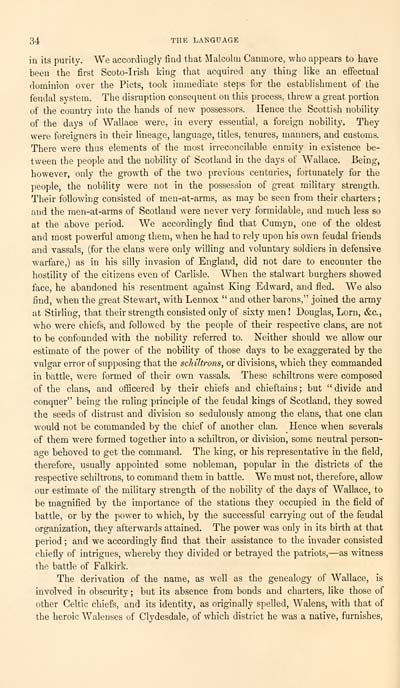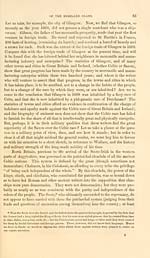Download files
Complete book:
Individual page:
Thumbnail gallery: Grid view | List view

34 THE LAKGDAGE
in its purity. We accordingly find that Malcolm Canmore, who appears to have
been the first Scoto-Irish king that acquired any thing like an effectual
dominion over the Picts, took immediate steps for the establishment of the
feudal system. The disruption consequent on this process, threw a great portion
of the country into the hands of new possessors. Hence the Scottish nobility
of the days of Wallace were, in every essential, a foreign nobility. They
were foreigners in their lineage, language, titles, tenures, manners, and customs.
There were thus elements of the most irreconcilable enmity in existence be-
tween the people and the nobility of Scotland in the days of Wallace. Being,
however, only the growth of the two previous centuries, fortunately for the
jieople, the nobility were not in the possession of great military strength.
Their following consisted of men-at-arms, as may be seen from their charters ;
and the men-at-arms of Scotland were never very formidable, and much less so
at the above period. We accordingly find that Cumyn, one of the oldest
and most powerful among them, when he had to rely upon his own feudal friends
and vassals, (for the clans were only willing and voluntary soldiers in defensive
warfare,) as in his silly invasion of England, did not dare to encounter the
hostility of the citizens even of Carlisle. When the stalwart burghers showed
face, he abandoned his resentment against King Edward, and fled. We also
find, when the great Stewart, with Lennox " and other barons," joined the army
at Stirling, that their strength consisted only of sixty men ! Douglas, Lorn, &c.,
who were chiefs, and followed by the people of their respective clans, are not
to be confounded with the nobility referred to. Neither should we allow our
estimate of the power of the nobility of those days to be exaggerated by the
vulgar error of supposing that the scJiiltrons, or divisions, which they commanded
in battle, were formed of their own vassals. These schiltrons were composed
of the clans, and officered by their chiefs and chieftains ; but " divide and
conquer" being the ruling principle of the feudal kings of Scotland, they sowed
the seeds of distrust and division so sedulously among the clans, that one clan
would not be commanded by the chief of another clan. Hence when severals
of them were formed together into a schiltron, or division, some neutral person-
age behoved to get the command. The king, or his representative in the field,
therefore, usually appointed some nobleman, popular in the districts of the
respective schiltrons, to command them in battle. We must not, therefore, allow
our estimate of the military strength of the nobility of the days of Wallace, to
be magnified by the importance of the stations they occupied in the field of
battle, or by the power to which, by the successful carrying out of the feudal
organization, they afterwards attained. The power w-as only in its birth at that
period ; and we accordingly find that their assistance to the invader consisted
chiefly of intrigues, whereby they divided or betrayed the patriots, — as witness
the battle of Falkirk.
The derivation of the name, as well as the genealogy of Wallace, is
involved in obscurity ; but its absence from bonds and charters, like those of
other Celtic chiefs, and its identity, as originally spelled, Walens, with that of
the heroic Walenses of Clydesdale, of wdiich district he was a native, furnishes,
in its purity. We accordingly find that Malcolm Canmore, who appears to have
been the first Scoto-Irish king that acquired any thing like an effectual
dominion over the Picts, took immediate steps for the establishment of the
feudal system. The disruption consequent on this process, threw a great portion
of the country into the hands of new possessors. Hence the Scottish nobility
of the days of Wallace were, in every essential, a foreign nobility. They
were foreigners in their lineage, language, titles, tenures, manners, and customs.
There were thus elements of the most irreconcilable enmity in existence be-
tween the people and the nobility of Scotland in the days of Wallace. Being,
however, only the growth of the two previous centuries, fortunately for the
jieople, the nobility were not in the possession of great military strength.
Their following consisted of men-at-arms, as may be seen from their charters ;
and the men-at-arms of Scotland were never very formidable, and much less so
at the above period. We accordingly find that Cumyn, one of the oldest
and most powerful among them, when he had to rely upon his own feudal friends
and vassals, (for the clans were only willing and voluntary soldiers in defensive
warfare,) as in his silly invasion of England, did not dare to encounter the
hostility of the citizens even of Carlisle. When the stalwart burghers showed
face, he abandoned his resentment against King Edward, and fled. We also
find, when the great Stewart, with Lennox " and other barons," joined the army
at Stirling, that their strength consisted only of sixty men ! Douglas, Lorn, &c.,
who were chiefs, and followed by the people of their respective clans, are not
to be confounded with the nobility referred to. Neither should we allow our
estimate of the power of the nobility of those days to be exaggerated by the
vulgar error of supposing that the scJiiltrons, or divisions, which they commanded
in battle, were formed of their own vassals. These schiltrons were composed
of the clans, and officered by their chiefs and chieftains ; but " divide and
conquer" being the ruling principle of the feudal kings of Scotland, they sowed
the seeds of distrust and division so sedulously among the clans, that one clan
would not be commanded by the chief of another clan. Hence when severals
of them were formed together into a schiltron, or division, some neutral person-
age behoved to get the command. The king, or his representative in the field,
therefore, usually appointed some nobleman, popular in the districts of the
respective schiltrons, to command them in battle. We must not, therefore, allow
our estimate of the military strength of the nobility of the days of Wallace, to
be magnified by the importance of the stations they occupied in the field of
battle, or by the power to which, by the successful carrying out of the feudal
organization, they afterwards attained. The power w-as only in its birth at that
period ; and we accordingly find that their assistance to the invader consisted
chiefly of intrigues, whereby they divided or betrayed the patriots, — as witness
the battle of Falkirk.
The derivation of the name, as well as the genealogy of Wallace, is
involved in obscurity ; but its absence from bonds and charters, like those of
other Celtic chiefs, and its identity, as originally spelled, Walens, with that of
the heroic Walenses of Clydesdale, of wdiich district he was a native, furnishes,
Set display mode to: Large image | Transcription
Images and transcriptions on this page, including medium image downloads, may be used under the Creative Commons Attribution 4.0 International Licence unless otherwise stated. ![]()
| Early Gaelic Book Collections > Blair Collection > Treatise on the language, poetry, and music of the Highland clans > (46) |
|---|
| Permanent URL | https://digital.nls.uk/76236909 |
|---|
| Description | A selection of books from a collection of more than 500 titles, mostly on religious and literary topics. Also includes some material dealing with other Celtic languages and societies. Collection created towards the end of the 19th century by Lady Evelyn Stewart Murray. |
|---|
| Description | Selected items from five 'Special and Named Printed Collections'. Includes books in Gaelic and other Celtic languages, works about the Gaels, their languages, literature, culture and history. |
|---|

